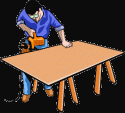Cabinetmaker

Cabinetmakers build, repair, finish and install residential and commercial cabinets (including hardware), wooden furniture and architectural millwork using a variety of woods, laminates and other products. Cabinetmakers read drawings and specifications, and prepare layouts. They also set up and operate woodworking equipment, both power and computerized, to machine wood products and composite materials. Cabinetmakers use various power tools and precision woodworking tools to perform their work. Cabinetmakers sand and finish the surfaces either before or after assembly in some shops. They also apply finishing products.
Cabinetmakers are employed by millwork contractors, furniture manufacturers and general contractors. They may also be self-employed. The products they produce may be production or custom-made pieces. Production pieces are made in large quantities and according to a standard design. Custom-made pieces are often from one-of-a-kind designs and are not mass‑produced. Some cabinetmakers specialize in a specific type of product, such as custom‑made furniture, stairs or cabinet doors. In large cabinet making shops using high-tech, computer-controlled equipment, cabinetmakers may specialize in one or two functions. A working knowledge of the design principles, functional requirements, and traditions associated with furniture building is also advantageous in many areas of the cabinetmaker trade.
Cabinetmakers primarily work in a shop environment, but they may also work at locations where the products are installed. While the working environment varies according to employers and locations, cabinetmakers are often exposed to workplace health and safety risks such as high noise levels, sawdust and chemicals. There are risks of injury involved in working with woodworking machinery, portable power tools and hand tools.
Key attributes for people in this trade are good eye-hand coordination, manual dexterity, mathematical aptitude and good conceptual skills. Cabinetmakers require a high degree of accuracy, and good eyesight to select woods and look for imperfections. The work may require lifting of heavy materials.
This analysis recognizes similarities or overlaps with the work of carpenters and painters/decorators.
With experience, cabinetmakers may act as mentors and trainers to apprentices in the trade. They may advance to supervisory or design positions or may set up their own shop. Some may choose to specialize in areas such as stairs, veneering or finishing.





Leave a comment!